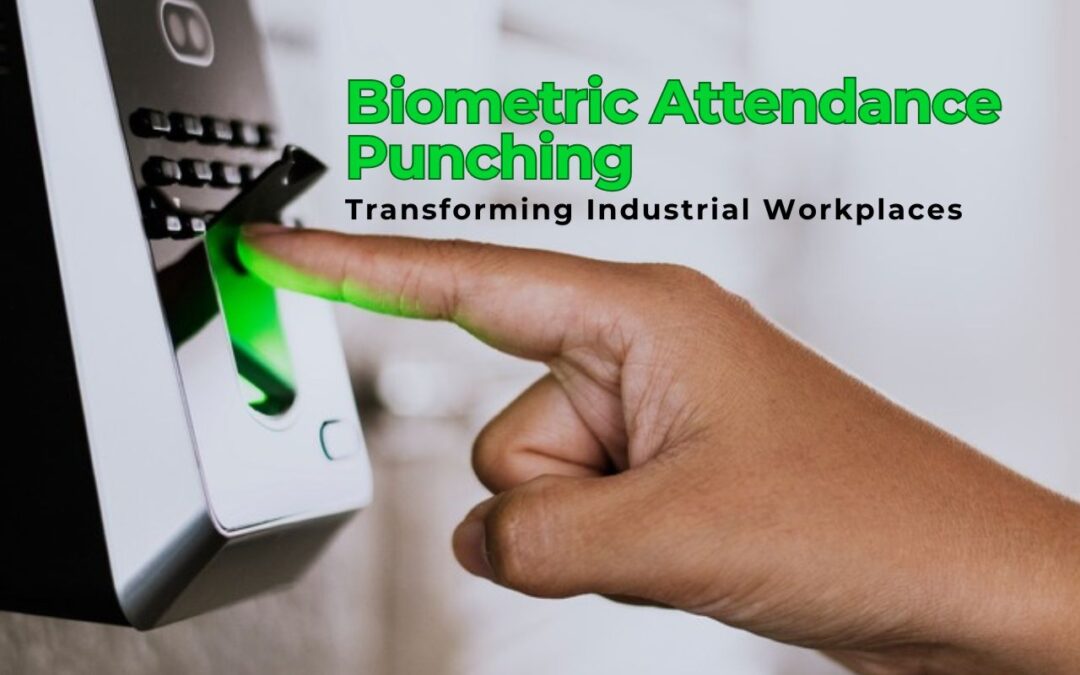In today’s highly competitive industrial landscape, maintaining operational efficiency, securing sensitive areas, and ensuring employee accountability are critical for success. Outdated methods of attendance tracking—such as manual registers and punch cards—fail to meet modern standards for accuracy and security. As industries evolve and digitization becomes the norm, biometric attendance punching tools are revolutionizing how industrial workplaces manage and monitor their workforce.
This blog explores the far-reaching impact of biometric attendance systems in industrial environments, highlighting their benefits, applications, challenges, and future trends.
What Are Biometric Attendance Punching Tools?
Biometric attendance tools are automated systems that use unique biological traits to authenticate individuals. Common modalities include:
- Fingerprint Scanning
- Facial Recognition
- Iris Recognition
- Voice Recognition
- Hand Geometry
Unlike traditional methods that rely on ID cards or PINs, which can be lost or shared, biometric systems provide a foolproof method of identifying individuals.
Benefits of Biometric Attendance in Industrial Workplaces
1. Unmatched Accuracy and Reliability
In industrial environments where hundreds or even thousands of workers operate in shifts, accuracy in attendance tracking is paramount. Biometric systems capture exact entry and exit times, eliminating any ambiguity.
This level of precision reduces:
- Payroll errors
- Unauthorized overtime
- Time theft (“buddy punching”)
2. Increased Operational Efficiency
Traditional attendance methods often require manual data entry, reconciliation, and review. Biometric systems automate these tasks, freeing up HR personnel to focus on strategic initiatives rather than clerical work.
Moreover, real-time data collection enables:
- Swift shift adjustments
- Improved staff deployment
- Enhanced labor forecasting
3. Seamless Payroll Integration
Many biometric systems come with integration capabilities for payroll and HR software. This synergy enables automatic calculation of:
- Work hours
- Overtime
- Absences
By automating payroll processing, companies can reduce:
- Administrative costs
- Payment disputes
- Compliance risks
4. Enhanced Workplace Security
Security is a critical concern, especially in sectors such as pharmaceuticals, chemicals, energy, and defense. Biometric tools ensure that only authorized personnel can access specific zones, helping prevent:
- Unauthorized entry
- Data breaches
- Safety violations
5. Reduced Costs Over Time
Although the upfront cost of installing biometric systems may be significant, the long-term savings outweigh the initial investment. Companies benefit from:
- Reduced fraud
- Fewer administrative errors
- Lower manpower requirements
6. Better Compliance with Labor Laws
Accurate tracking ensures adherence to labor laws and union agreements. This is crucial in avoiding:
- Fines
- Penalties
- Legal disputes
Sector-Specific Applications of Biometric Attendance Tools
Manufacturing Plants
In high-volume manufacturing units, fingerprint-based attendance is common. Workers’ shifts can be tightly monitored, ensuring smooth handovers and minimal downtime. Attendance data can also help in identifying high-performing teams and areas needing improvement.
Oil & Gas Refineries
These are high-risk environments where safety is paramount. Facial recognition and iris scanning offer a contactless and secure way of monitoring worker presence. Entry can be restricted to those with specific training or certifications.
Construction Sites
Biometric tools are now available in portable forms, ideal for remote or temporary work sites. These devices are especially useful in:
- Ensuring timely arrival and departure
- Tracking contract workers
- Managing wage distribution
Warehousing and Logistics
In 24/7 logistics operations, it is crucial to track who is on-site at any given time. Biometric attendance tools allow:
- Real-time personnel tracking
- Shift scheduling optimization
- Performance-based accountability
Food Processing Units
Here, hygiene is critical. Touchless biometric systems such as facial recognition or iris scans minimize physical contact, preserving sanitary conditions while ensuring attendance reliability.
Challenges and How to Overcome Them
1. Privacy Concerns
Challenge: Employees may feel uneasy about the storage and use of their biometric data.
Solution:
- Adopt systems compliant with GDPR and other privacy regulations.
- Use end-to-end encryption.
- Clearly communicate data usage policies.
- Allow employee opt-in where legally feasible.
2. Technical Limitations
Challenge: In environments with dust, oil, or grease, fingerprint scanners may malfunction.
Solution:
- Use multi-modal systems combining fingerprint, facial, and voice recognition.
- Employ rugged devices designed for industrial settings.
3. Power and Connectivity Issues
Challenge: Remote locations may experience frequent outages.
Solution:
- Use devices with battery backup.
- Implement cloud-based systems with offline syncing capabilities.
4. Initial Investment Cost
Challenge: Budget constraints in small to mid-sized enterprises.
Solution:
- Start with scalable systems.
- Explore leasing or subscription-based biometric services.
- Calculate ROI through case studies and pilot projects.
Real-Life Success Stories
Case Study 1: Automotive Manufacturing Plant in Pune, India
After implementing a fingerprint-based biometric attendance system, the plant observed:
- 20% reduction in shift overlaps
- 30% fewer payroll discrepancies
- Improved worker punctuality and morale
Case Study 2: Oil Refinery in Texas
Facial recognition and access control tools helped:
- Reduce unauthorized entries by 95%
- Improve compliance reporting
- Streamline emergency evacuation planning with accurate headcounts
Case Study 3: Large Warehouse Chain in Germany
By switching from manual logs to a cloud-based biometric solution:
- Inventory mismanagement dropped by 18%
- Employee attendance accuracy rose to 99.7%
- Labor costs reduced by 12%
Integration with Advanced Technologies
Biometric systems are no longer standalone tools. They are being integrated with:
Artificial Intelligence (AI)
AI-driven systems can analyze attendance data to:
- Predict absenteeism
- Automate resource planning
- Detect anomalies (e.g., duplicate entries)
Internet of Things (IoT)
Integration with IoT devices enables real-time:
- Environmental monitoring
- Equipment usage linked to personnel access
Cloud Computing
Cloud-based biometric systems offer:
- Remote access to data
- Secure backups
- Scalability for growing operations
Mobile and Wearable Integration
Smartphones and wearables can now serve as portable biometric scanners, enabling:
- Field worker attendance
- Location-based check-ins
- Geo-fencing for area-specific access
The Future of Biometric Attendance in Industry
The biometric industry is evolving rapidly, with upcoming trends such as:
1. Touchless Biometrics
Driven by health and hygiene concerns, systems are moving toward:
- Facial recognition
- Iris scanning
- Palm-vein scanning
2. Behavioral Biometrics
These systems identify individuals based on behavioral traits such as:
- Typing speed
- Mouse movement patterns
- Walking gait
3. Blockchain Integration
Decentralized biometric data storage will:
- Enhance security
- Improve transparency
- Prevent data tampering
4. Voice-Activated Attendance
Especially useful in noisy industrial environments with hands-free needs, voice recognition tools offer convenience and accessibility.
Key Considerations Before Implementation
Before adopting biometric tools in industrial environments, companies should consider:
- Workforce Size and Diversity: Choose a system that supports multilingual interfaces and diverse biometric profiles.
- Environmental Conditions: Devices must be rugged and weather-resistant.
- Data Security Protocols: Opt for solutions with secure encryption and compliance certifications.
- Training and Adoption: Provide sufficient training to staff to ensure smooth adoption.
- Scalability: Ensure the system can grow with your workforce and operational needs.
Final Thoughts
Biometric attendance punching tools have transitioned from a novelty to a necessity in modern industrial workplaces. Their ability to provide accurate, secure, and efficient workforce management makes them invaluable in an era driven by data and digital transformation.
From manufacturing units and oil refineries to construction sites and warehouses, industries across the globe are witnessing the transformative impact of biometric systems. As technology continues to evolve, these systems will become even more advanced, user-friendly, and integral to organizational success.
The Time to Invest Is Now
By integrating biometric attendance punching tools, industries not only improve operational efficiency but also gain a competitive edge. If your organization hasn’t yet explored the power of biometric systems, now is the perfect time to start.












